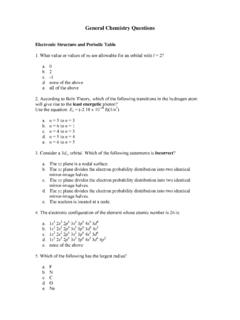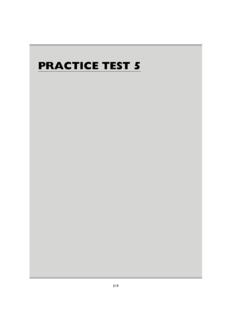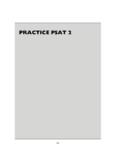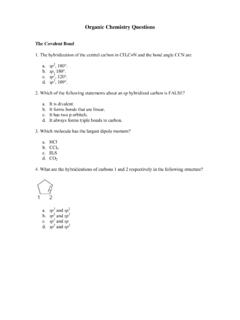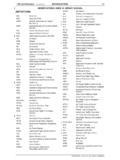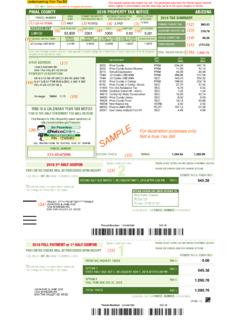Transcription of General Organic Chemistry Questions - McGraw Hill …
1 Organic Chemistry Questions The Covalent Bond 1. The hybridization of the central carbon in CH3C N and the bond angle CCN are a. sp2, 180 . b. sp, 180 . c. sp2, 120 . d. sp3, 109 . 2. Which of the following statements about an sp hybridized carbon is FALSE? a. It is divalent. b. It forms bonds that are linear. c. It has two p orbitals. d. It always forms triple bonds to carbon. 3. Which molecule has the largest dipole moment? a. HCl b. CCl4 c. H2S d. CO2 4. What are the hybridizations of carbons 1 and 2 respectively in the following structure? a. sp3 and sp2 b.
2 Sp2 and sp3 c. sp3 and sp d. sp2 and sp2 5. What are the hybridizations of atoms 1 and 2 respectively in the following structure? a. sp3 and sp2 b. sp2 and sp3 c. sp3 and sp d. sp2 and sp2 6. Identify the orbital hybridization at the two indicated carbons in the molecule below. a. C1: sp; C2: sp b. C1: sp2; C2: sp2 c. C1: sp; C2: sp2 d. C1: sp2; C2: sp 7. How many total resonance structures can be drawn for the following anion (include those without separation of charge)? a. 1 b. 2 c. 3 d. 4 8. How many resonance structures can be drawn for the following molecule?
3 A. 1 b. 4 c. 3 d. 2 9. The correct geometry around oxygen in CH3 OCH3 is a. linear. b. bent. c. tetrahedral. d. trigonal planar 10. Determine the relationship between the two molecules shown. a. constitutional isomers b. enantiomers c. diastereomers d. identical molecules 11. What is the correct name for this molecule? a. (2R,3R)-2-bromo-3-chlorobutane b. (2S,3R)-2-bromo-3-chlorobutane c. (2S,3S)-2-bromo-3-chlorobutane d. (2R,3S)-2-bromo-3-chlorobutane 12. What is the specific rotation 20[ ]D of the following molecule?
4 A. + b. + c. + d. 13. Which of the following physical properties differ for each of a pair of enantiomers? a. solubility in ethanol b. direction of rotation of plane-polarized light c. boiling point and melting point d. index of refraction 14. Determine the double bond stereochemistry (E or Z) for the following molecules. a. A: E; B: E b. A: Z; B: Z c. A: E; B: Z d. A: Z; B: E 15. Determine the double bond stereochemistry (E or Z) for the following molecules. a. A: E; B: E b. A: Z; B: Z c. A: E; B: Z d. A: Z; B: E Molecular Structure and Spectra 1.
5 A strong signal at 1700 cm 1 in an IR spectrum indicates the presence of a(n) a. alcohol b. ether c. carbonyl d. amine 2. A strong signal at 3400 cm 1 in an IR spectrum indicates the presence of a(n) a. alcohol b. ether c. carbonyl d. amine 3. Deduce the structure of an unknown compound with molecular formula C5H12O using information given by its infrared spectrum. Intensity (peak): Frequency (cm 1): m 3300 m 2900 m 2800 m 1465 m 1450 m 1375 a.
6 B. c. d. 4. Deduce the structure of an unknown compound with molecular formula C9H10O using information given by its infrared spectrum. Intensity (peak): Frequency (cm 1): s 3100 m 2900 m 2800 s 1710 m-w 1600 m-w 1475 m 1465 m 1450 m
7 1375 a. b. c. d. 5. Deduce the structure of an unknown compound with molecular formula C5H8O using information given by its infrared spectrum. Intensity (peak): Frequency (cm 1): m 3100 m 2800 s 1705 m-w 1640 m 1450 m 1375 a.
8 B. c. d. 6. Which of the following compounds a d has an IR absorption at 3300 cm 1? a. a b. b c. c d. d 7. When an external magnetic field is applied, what happens to the protons in a sample? a. All protons align with the field. b. All protons align opposite to the field. c. Some protons align with the field and some align opposite to it. d. All protons assume a random orientation 8. Which of the following compounds has the MOST deshielded protons? a. CH3Cl b. CH3I c. CH3Br d. CH4 9. Arrange the following compounds in order of decreasing chemical shift for the underlined hydrogens (largest value first, smallest value last).
9 CH3CH2CH3 CH3 OCH2CH3 Cl2 CHCH2CH3 ClCH2CH2CH3 a b c d a. b > c > a > d b. b > c > d > a c. c > b > a > d d. c > b > d > a 10. An unknown molecule A has 4 signals in the 1H NMR spectrum. Which of the following corresponds to molecule A? a. b. c. d. 11. Deduce the structure of an unknown compound using the following 1H NMR spectrum, mass spectroscopy data, and IR spectrum. 1H NMR spectrum: (triplet, 6H) (quartet, 4H) (multiplet, 4H) Mass Spectrum: m/e: Intensity: (as % of base peak) 222 10% 177 38% 149 100% IR Spectrum: Intensity (peak): Frequency (cm 1).
10 S 3100 m 2900 m 2800 s 1740 m-w 1600 m-w 1475 m 1465 m 1450 m 1375 s 1300 1000 a.
